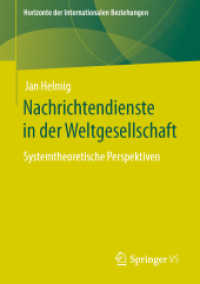- ホーム
- > 洋書
- > 英文書
- > Science / Mathematics
基本説明
Reprinted from PLANT AND SOIL, 248.
Full Description
The availability of soil phosphorus (P) frequently limits plant growth in both natural and agricultural systems. In agricultural systems the application of P fertilisers often leads to environmental problems. Moreover, readily available sources for P fertilisers will be depleted by the end of this century. To decrease our dependence on P fertilisers, a better understanding of the scavenging, uptake and use of P by plants is quintessential. In this respect, we may learn from plant species that form cluster roots (highly branched specialised root structures), as these are extremely effective in mobilising sparingly soluble soil minerals such as P. How do these roots achieve this? Is their effective P scavenging and uptake mainly a result of their different morphology, or are there also physiological or biochemical differences between cluster-rooted and non-cluster rooted species? The multidisciplinary workshop at which the papers in this volume were presented aimed at describing the state of the art on P scavenging, uptake and use, in species with and without cluster roots, by discussing these issues amongst a group of leading international scientists.
Contents
Introduction; H. Lambers, et al. The biology of cluster roots and the acquisition of P from the rhizosphere. Structure, ecology and physiology of root clusters a review; B.B. Lamont. The evolution of physiology and development in the cluster root: teaching an old dog new tricks? K.R. Skene. Organic acid behaviour in soils misconceptions and knowledge gaps; D.L. Jones, et al. Origins of root-mediated pH changes in the rhizosphere and their responses to environmental constraints: A review; P. Hinsinger, et al. Strategies to isolate transporters that facilitate organic anion efflux from plant roots; P.R. Ryan, et al. Phosphate transport in plants; F.W. Smith, et al. Development of the adhesive pad on climbing fig (Ficus punila) stems from clusters of adventitious roots; E.P. Groot, et al. Pathways of carbon metabolism related to enhanced exudation of organic acids and acid phosphatase. Acclimation of white lupin to phosphorus deficiency involves enhanced expression of genes related to organic acid metabolism; C. Uhde-Stone, et al. Phosphorus deficiency-induced modifications in citrate catabolism and in cystolic pH as related to citrate exudation in cluster roots of white lupin; A. Kania. Secreted acid phosphatase is expressed in cluster roots of lupin in response to phosphorus deficiency; J. Wasaki, et al. Effects of altered citrate synthase and isocitrate dehydrogenase expression on internal citrate concentrations and citrate efflux from tobacco (Nicotiana tabacum L.) roots; E. Delhaize, et al. Characterization of NAPD-isocitrate dehydrogenase expression in a carrot mutant cell line with enhanced citrate excretion; T. Kihara, et al. The influence of organic acid exudation and cluster roots on P and N acquisition. Do cluster roots of Hakea actities (Proteaceae) acquire complex organic nitrogen? S. Schmidt, et al. Lupinus luteus cv. Wodjil takes up more phosphorus and cadmium than Lupinus angustifolius cv. Kalya; R.F. Brennan, M.D.A. Bolland. Chick pea and white lupin rhizosphere carboxylates vary with soil properties and enhance phosphorus uptake; E.J. Veneklaas, et al. Role of phosphorus nutrition in development of cluster roots and release of carboxylates in soil-grown Lupinus albus; J. Shen, et al. The influence of plant nutrition on plant growth and development of cluster roots. Effects of external phosphorus supply on internal phosphorus concentration and the initiation, growth and exudation of cluster roots in Hahea prostrata R. Br.; M.W. Shane, et al. Differences in cluster root formation and carboxylate exudation in Lupinus albus L. under different nutrient deficiencies; R. Liang, C. Li. Is Fe deficiency rather than P deficiency the cause of cluster root formation in Casuarina species? E.H. Zaid, et al. The formation, morphology and anatomy of cluster root of Lupinus albus L. as dependent on soil type and phosphorus supply; C.S. Peek, et al. Localized supply of phosphorus induces root morphological and architectural changes of rice in split and stratified soil cultures; Y. He, et al. Interaction of nitrogen and phosphorus nutrition in determining growth; C.C.de Groot, et al. Implications of root architecture, root-soil interactions and mycorrhiza on plant P nutrition. Phosphorus acquisition from soil by white lupin (Lupinus albus L.) and soybean (Glycine max L.) species with contrasting root development; M. Watt, J.R. Evans. Plantago lanceolata L. and Rumex acetosella L. differ in their utilisation of soil phosphorus fractions; A.-M. Fransson, et al. Chickpea facilitates phosphorus uptake by intercropped wheat from an organic phosphorus source; L. Li, et al. Using competitive and facilitative interactions in intercropping systems enhances crop productivity and nutrient-use efficiency; F. Zhang, L. Li. Phosphorus uptake by a community of arbuscular mycorrhizal fungi in jarrah forest; M.Z. Solaiman, L.K. Abbott. Relationships between cluster root-bearing taxa and laterite across landscapes in southwest Western Australia: an approach using airborne radiometric and digital elevation models; W.H. Verboom, J.S. Pate. Volume contents. Author index.







